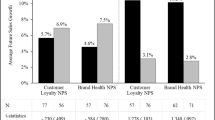Abstract
For more than 50 years, numerous studies have shown low price–quality correlation coefficients, mostly close to 0.2. That prices fail to function as valid indicators of product quality has been interpreted as informational market failure. This article, however, argues, that, according to the economic theory of price formation, prices are not an indicator of quality, but an indicator of scarcity. This allows the conclusion that workable consumer goods markets, at least as seen from the consumer’s point of view, should be characterized by low or even negative correlation coefficients rather than by strong positive coefficients.


Similar content being viewed by others
References
Beier, U. (1978). Entscheidungsbedingte Kaufkraftverluste. Zeitschrift für Verbraucherpolitik, 2, 159–171.
Diller, H. (1977). Der Preis als Qualitätsindikator. Die Betriebswirtschaft, 37, 219–234.
Geistfeld, L. V. (1982). The price quality relationship – revisited. Journal of Consumer Affairs, 16, 334–346.
Geistfeld, L. V. (1988). The price quality relationship: The evidence we have, the evidence we need. In E. S. Maynes (Ed.), The frontier of research in the consumer interest (pp. 143–172). Columbia, MO: American Council on Consumer Interests.
Hjorth-Andersen, C. (1987). Price as a risk indicator. Journal of Consumer Policy, 10, 267–281.
Imkamp, H. (2003). Der Preis – ein schlechter Qualitätsindikator? Die Betriebswirtschaft, 63, 378–384.
Imkamp, H. (2004). Mangelnde Funktionsfähigkeit von Konsumgütermärkten? Jahrbuch für Wirtschaftswissenschaften, 55, 106–125.
Imkamp, H., & Beckermann, M. (2007). Ist der Preis auf lokalen Konsumgütermärkten ein besserer Qualitätsindikator als auf nationalen Märkten? Hauswirtschaft und Wissenschaft, 55, 126–137.
Maynes, E. S. (1979). Consumer protection: The issues. Journal of Consumer Policy, 3, 97–109.
Morris, R. T., & Bronson, C. S. (1969). The chaos of competition indicated by consumer reports. Journal of Marketing, 33, 26–34.
Morris, R. T., & Bronson, C. S. (1970). The potential loss in money income to the American people by haphazard purchasing. Journal of Consumer Affairs, 4, 103–112.
Ratchford, B. T., Agrawal, J., Grimm, P. E., & Srinivasan, N. (1996). Toward understanding the measurement of market efficiency. Journal of Public Policy and Marketing, 15, 167–198.
Ratchford, B. T., & Gupta, P. (1990). On the interpretation of price–quality relations. Journal of Consumer Policy, 13, 389–411.
Ratchford, B. T., & Gupta, P. (1992). On estimating market efficiency. Journal of Consumer Policy, 15, 275–293.
Yamada, Y., & Ackerman, N. (1984). Price–quality correlations in the Japanese market. Journal of Consumer Affairs, 18, 251–265.
Author information
Authors and Affiliations
Corresponding author
Rights and permissions
About this article
Cite this article
Imkamp, H. A New Look at Old Coefficients. J Consum Policy 31, 139–145 (2008). https://doi.org/10.1007/s10603-007-9052-3
Received:
Accepted:
Published:
Issue Date:
DOI: https://doi.org/10.1007/s10603-007-9052-3




